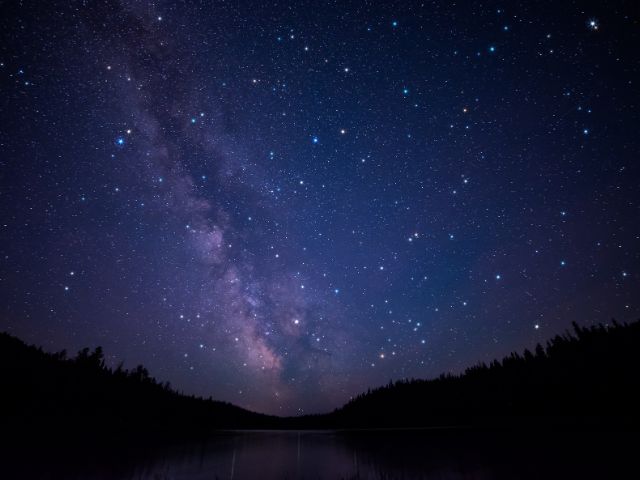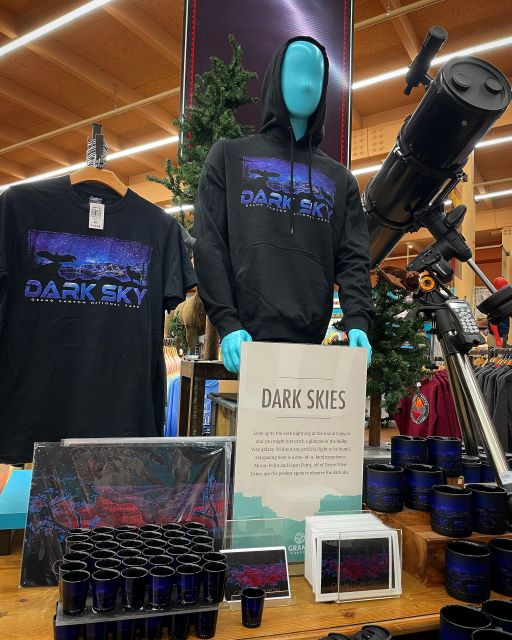
What do Earth Day and International Dark Sky Week have in common? The month of April, during which they’re both observed. Which is fitting. April is when Spring really gets underway. A lot of us find ourselves getting outside more to enjoy Mother Nature again.
And that’s something else both days share in common: the environment and raising awareness about how to better appreciate it. In International Dark Sky Week’s case, their mission is to raise awareness about light pollution. Let’s take a look.
Night Sky Sanctuaries

Many things astounded me on our jaunt to the Grand Canyon in 2021. I’d been there before but not for decades. But it was something I watched one night in our hotel room that has particularly haunted me ever since. It’s changed the way I view the night sky.
We stayed inside the park at Yavapai Lodge, which had a channel that played various programs about the park on a loop. One was titled “Night Sky – Grand Canyon in Depth – Episode 4.”
Park Ranger Rader Lane explained what makes night sky viewing unique in the Grand Canyon. Not only is the light pollution limited (even though some still seeps in from Flagstaff, Las Vegas, and Williams), but it has to do with the elevation.
We’re situated high above a good portion of the atmosphere here on the Colorado Plateau. So we’re at 7,000 feet here on the South Rim, which allows us to see the night sky without the distortion of atmosphere, molecules, aerosols, dust… If you look at a light pollution map of the United States, the East Coast is pretty much completely white-washed with excess light and light pollution, whereas in the southwest there are still completely dark patches left, and so they’ve become somewhat of sanctuaries for the night.
The Grand Canyon is among those places that serve as both a night sky park and a night sky sanctuary.
But it was something that astronomer Dr. Tyler Nordgren said that chilled me. I’ve thought of it every night since when I look up.
In the city where I live, I can look up into the sky, and I can count all the stars there. In fact, that’s a question that almost every child has at some point. How many stars are there in the sky? Well, sadly, I know that in the city where I live, the answer is 12. And one of those is probably an airplane. As a result, there’s very few incentives for me to ever look at the sky anymore. And 50% of the world’s population now lives in cities, under those types of skies. What reason does a child ever have to look up anymore? There’s nothing there. There’s nothing to be seen. And, so, we’ve lost something, we’ve lost something really fundamental, not just about our natural world, but how we see that world, how we see ourselves, how we approach the great questions of life.
Basically, we’ve lost the wonder.
It was a concept that blew my mind. I’d never thought about the impact of light pollution in this way before. Nor had I considered how much I take the night sky for granted –or that half the people live in a world without any stars.
International Dark Sky Week Seeks to Protect the Night
On the About page for the International Dark Sky Week website, they explain that the International Dark-Sky Association (IDA) “protects the night from light pollution.” Here’s the statement that echoes some of what Park Ranger Lane and Dr. Nordgren also expressed:
Artificial light at night has revolutionized the way we live and work outdoors, but it has come at a price. When used indiscriminately, outdoor lighting can disrupt wildlife, impact human health, waste money, and energy, contribute to climate change, and block our view of the universe.
But how does one go about protecting the night? They do it through education and community. Their Take Action page outlines ways to get involved, such as by becoming a community scientist, partnering with other organizations, hosting a night walk, taking inventory of your home lighting, etc.
Their Events tab lists all the places holding just that, events. Whether they’re called dark sky, star parties, or even “cosmic adventures,” it’s a good place to find events worldwide. We’re talking everywhere from Victoria, Australia; Rocha, Uruguay; and Nairobi, Kenya to Santa Fe, New Mexico and Marathon, Texas.
When International Night Sky Week Happens
International Night Sky Week never falls on the same date each year, but it always takes place in April. Specifically, it happens during the week of the new moon in April.
For More Info
To learn more about how to celebrate International Dark Sky Week, visit https://idsw.darksky.org.
And to find other Weird Holidays & Observances, visit https://www.hauntjaunts.net/reference/weird-holidays-observances.
Check-In
When was the last time you saw the Milky Way?
Courtney Mroch is a globe-trotting restless spirit who’s both possessed by wanderlust and the spirit of adventure, as well as obsessed with true crime, horror, the paranormal, and weird days. Perhaps it has something to do with her genes? She is related to occult royalty, after all. Marie Laveau, the famous Voodoo practitioner of New Orleans, is one of her ancestors. That could also explain her infatuation with skeletons.
Speaking of healing, to learn how she channeled her battle with cancer to conjure up this site, check out HJ’s Origin Story.

You KNOW with my husband being an amateur astronomer that I’m very aware of light pollution. We live in the boonies on purpose to have darker skies. I saw the Milky Way last month. It’s amazing how many people put up tall, bright security lights or garden uplights without thinking of light pollution and the effect it has on critters (like frogs, European hornets, tarantula hawks, etc.).
Wouldn’t it be fun to take one of those dark skies cruises where they turn off the ship lights in the middle of the ocean so you can see the sky?!
New Mexico is a dark sky state. They try to keep the light pollution down and once you drive away from any city or town and look up (weather/dust storms permitting) you can see the Milky Way.
Ahhhhh!!!! Okay, if you mentioned your hub is an amateur astronomer before, it did not stick. But I love finding it out (or re-finding it out, as the case may be) now. And even cooler to learn you purposely chose where you live now to better appreciate the night sky. I do know from living in FL…when we first moved there we had frogs aplenty! These cute little ones that would come out at night and stick to our windows. But then…more construction, more lights and no more froges. It’s horrible to see the damage first-hand. BUT part of why I love cruising is our nighttime strolls on deck. We’ve never been on a ship that turned their lights off BUT now I will search for that kind of cruise! BUT we do often get spectacular views of the night sky anyway. Those moments center my soul.
Ooo! You might have just sparked an upcoming post, Maria! I have plans to do one about places to find dark sky parks…but states?! That would be a cool post (that I could also translate into a video!) too! THANKS for being a muse!